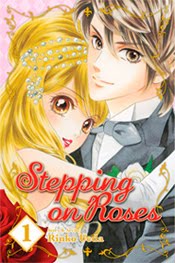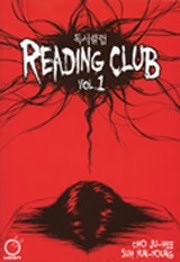 If terror like Ringu is what you enjoy, then try out The Reading Club by Cho Ju-Hee and Suh Yun-Young. A manhwa that combines gory horror and romance, The Reading Club revolves around a cursed book that leads its readers into gruesome circumstances. The couples include a high school student that decides she's going to keep her crush from being destroyed by the book, and local coroner and cop that have a flirtatious relationship. Chilling artwork adds to the eerie quality of this recent series. ♥♥♥
If terror like Ringu is what you enjoy, then try out The Reading Club by Cho Ju-Hee and Suh Yun-Young. A manhwa that combines gory horror and romance, The Reading Club revolves around a cursed book that leads its readers into gruesome circumstances. The couples include a high school student that decides she's going to keep her crush from being destroyed by the book, and local coroner and cop that have a flirtatious relationship. Chilling artwork adds to the eerie quality of this recent series. ♥♥♥Not into all the gore? You might prefer a tamer series like Ghost Hunt written by Fuyumi
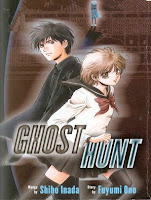 Ono and drawn by Shiho Inada. This paranormal series combines elements of mystery, suspense, and supernatural events that build a relationship between a spunky, not so average high school girl and a handsome, narcissistic seventeen year old genius. With a quirky cast consisting of high school students, psychics, a monk, a shinto shrine maiden, a Catholic priest, and a medium, Ghost Hunt provides plenty of characters to involve in romantic entanglements. Creepy cases and the hope of further developments between the lead characters keep readers coming back for more. ♥♥♥
Ono and drawn by Shiho Inada. This paranormal series combines elements of mystery, suspense, and supernatural events that build a relationship between a spunky, not so average high school girl and a handsome, narcissistic seventeen year old genius. With a quirky cast consisting of high school students, psychics, a monk, a shinto shrine maiden, a Catholic priest, and a medium, Ghost Hunt provides plenty of characters to involve in romantic entanglements. Creepy cases and the hope of further developments between the lead characters keep readers coming back for more. ♥♥♥Like the paranormal without all the darkness? A series like Yurara or Rasetsu by
 Chika Shiomi may be just what you'd enjoy. Yurara precedes Rasetsu in storyline, but both can be read independently with no problem. Stories with more chemistry than horror, these series follow attractive heroines with
Chika Shiomi may be just what you'd enjoy. Yurara precedes Rasetsu in storyline, but both can be read independently with no problem. Stories with more chemistry than horror, these series follow attractive heroines with 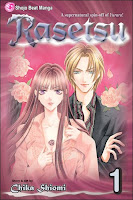 strong spiritual powers supported by a couple of hunky guys with their own rightful abilities. Their desire to help lost spirits leads them to finding love in the process. With all the beauties to look at, you'll never get tired of viewing these paranormal romances. ♥♥♥♥
strong spiritual powers supported by a couple of hunky guys with their own rightful abilities. Their desire to help lost spirits leads them to finding love in the process. With all the beauties to look at, you'll never get tired of viewing these paranormal romances. ♥♥♥♥Speaking
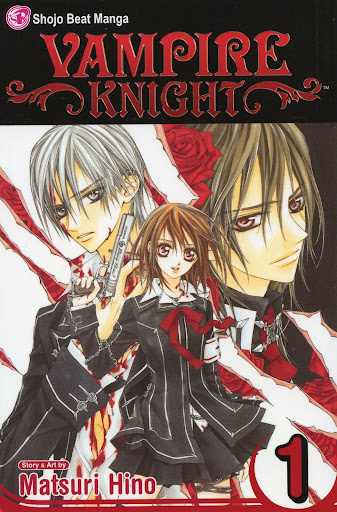 of beauties, let's not forget the vampires! If you like it dark and dramatic then be sure to dig into Vampire Knight by Matsuri Hino. Set at a boarding school for humans and vampires, main character Yuki seeks her forgotten memories. In her search she encounters Zero and Kaname, both set on protecting Yuki from whatever dangers she must face. ♥♥♥♥♥
of beauties, let's not forget the vampires! If you like it dark and dramatic then be sure to dig into Vampire Knight by Matsuri Hino. Set at a boarding school for humans and vampires, main character Yuki seeks her forgotten memories. In her search she encounters Zero and Kaname, both set on protecting Yuki from whatever dangers she must face. ♥♥♥♥♥ If you prefer comedy over drama, then you need to check out Chibi Vampire (aka
 . Karin) by Yuna Kagesaki. A shojo that makes fun of its own genre at times, this series approaches vampire lore from a unique angle. Karin just can't fit in as a human or a vampire. Unlike most vampires, Karin doesn't suck. She instead overproduces the amount of blood in her body and must inject it into someone at least once a month. That is, until she meets Kenta, and her system goes off kilter. Just being in Kenta's presence causes Karin the urge to inject others with blood - and she can't get away from seeing him, as they're in the same class and work at the same establishment. Kagesaki's sense of irony lends itself to some great comedic moments. ♥♥♥
. Karin) by Yuna Kagesaki. A shojo that makes fun of its own genre at times, this series approaches vampire lore from a unique angle. Karin just can't fit in as a human or a vampire. Unlike most vampires, Karin doesn't suck. She instead overproduces the amount of blood in her body and must inject it into someone at least once a month. That is, until she meets Kenta, and her system goes off kilter. Just being in Kenta's presence causes Karin the urge to inject others with blood - and she can't get away from seeing him, as they're in the same class and work at the same establishment. Kagesaki's sense of irony lends itself to some great comedic moments. ♥♥♥So, as costumed critters scamper about these coming eves, consider meeting some colorful characters yourself. Whether you're in the mood to laugh or scream, supernatural shojo manga's got you covered.

